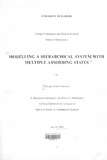| dc.description.abstract | Previous studies on the education system, which is hierarchical in nature, made use of Markov
chain transition models, comprising a single absorbing state. This work considers a Markov
chain transition model consisting of multiple absorbing states which takes care of those who
attain final maximum grade and those who leave the system before attaining the final grade,
which is more realistic.
The purpose of this study is to extend or generalize the original idea of one absorbing state
to multiple absorbing states based on grade retention rates, dropout rates, completion rates,
survival times and expected length of stay in University education. The work further looks
at the merits and demerits of the above considerations, that is, single and multiple absorbing
states | en |

